I’ve been looking for an article like this for a long time but haven’t really stumbled across one. Packing for a vacation is pretty straightforward. You know your climate and generally you’re only going to be gone for 2-3 weeks. But if you’re going vagabonding like me with no set time limit and no set destination, how do you leave prepared enough while still being as compact and light as possible? We also want to have a mix of traditional travel and wilderness adventures which typically require their own travel approach.
I’m going to go through how I approached it and I’ll be updating this article as my travels progress to share my learnings and insights. I feel pretty comfortable traveling with my current setup but I haven’t tested it through certain extremes that might require some adjustments.
Note, though I probably should figure it out, I don’t have any sponsored or affiliate links on this page. These are just products that I honestly like and the links provided are just for illustration. Not that there’s anything wrong with affiliate links, just saying.
What kind of bag should I take?

The first thing you need to consider is your bag. This will be your constant rugged companion so it’s worth investing a little up front to avoid some hard times later on.
Katy and I have settled on 40 liters to be the optimum size. This is a standard carry-on roller bag size and should fit most international carry-on standards. However many smaller domestic flights have smaller carry-on size and weight requirements. But I haven’t been able to go much smaller than this comfortably without switching my gear out from climate to climate.
Roller bag or backpack?
This is a hard one to answer and it’s very personal. I chose a roller bag because most of the places I want to go are urban and it allows me to carry a larger secondary backpack with my laptop and camera. Plus it takes the weight off my knees and gives me a longer range. Katy on the other hand is planning some longer through hikes like the Camino. She also likes the freedom of moving around on rough terrain where roller bags can’t roll. So she chose a travel oriented backpack with straps that pack up to survive plane travel but still comfortable enough for extended hiking. She carries a much lighter backpack that she wears on her front with her travel essentials.
My bag
After a lot of research and trying a few bags out on trips I decided on the Eagle Creek Gear Warrior carry on. 39L, 5lb 3oz.
This bag has enough room for my things, a thoughtful design, and rugged wheels that should keep going for a few years of hard wear. It’s light, which is important, a surprising amount of weight can be in your empty bag. It has big padded handles in multiple configurations which is great when you’re lugging it up and down subways stairs and through medieval cobblestone alleys. And it’s well made, good seams, thick fabric, it’s staying together. So far I’ve been able to get in and out of it with ease and I like it.
After much agonizing Katy went with REI’s Women’s Ruckpack 40 Pack. Which she’s been using for standard travel so far. I’ll let her discuss that more on her blog.
Also since I bought my bag Eagle Creek has introduced two new bags that I’m interested in checking out.
GEAR WARRIOR™ CONVERTIBLE CARRY ON
Clothes
The key to a light bag is a small amount of versatile clothes that can adapt to new climates, resist wrinkles, and dry fast. You will want to invest in a few things here. Synthetic travel clothes can be spendy but it’s going to make things a lot easier on you in the long run. I try things out and go with the things I like, which usually aren’t the most expensive trendy options. But if you can afford it a small investment can have high returns for you.
My clothes:
2 – Light synthetic pants that convert to shorts.
1 – Sleep shorts / swim trunks
1 – Light base layer leggings
1 – Cold layer (either thermal base layer or jeans)
1 – Casual thai pants for beach and lounging
1 – Long sleeve synthetic shirt
4 – Cotton tshirt
1 – Dress shirt
6 – Pairs short socks
4 – Pairs long socks
5 – Pairs synthetic underwear
1 – Light jacket
1 – Puffy coat
1 – Rain jacket
1 – Ultra light wind breaker
1 – Baseball cap
1 – Packable full shade hat
Pants and shorts
Personally I think the most versatile pants you can buy are REI’s Classic Sahara Convertible Pants. The classic version has full side length zips and the new ones have short side zips.
These are both pants and shorts and can convert between the two with ease. They’re the lightest pants I can find with the pockets I need so they work great in the desert. The current version has buttons instead of snaps which work much better, a handy built in waist cinch so you don’t need a belt. The legs also have a zipper all the way down the lower portion so it’s easy to remove them over shoes and boots. They seem to be wrinkle proof. Pack light. Fully synthetic so they dry super fast and don’t leach your bodyheat. And they come in grey which is more versatile when going from woods to nice restaurants. I used to wear the Columbia desert pants but they only came in green which didn’t work as well.
I have a dedicated pair of shorts that I use for sleeping that double as swim trunks. Well, they are swim trunks, but I mostly just sleep in them. These are light and dry fast and have pockets.
In addition to the pants I have light base layer leggings which can be used for sleeping or adding a thin second layer under the pants when things get colder. Also good for wearing when you’re doing laundry or lounging. Very comfortable.
For my colder weather layer I originally packed a thermal base layer to wear under the pants and a pair a jeans with the idea that I would try both out and see which worked best. Ideally I didn’t want to bring jeans because they’re heavy, bulky, and are cotton. But I ended up leaving the thermals with my mom and keeping the jeans. I didn’t think I would be in the weather that required them much and even in cold winters I tend to wear jeans at home. This is one of the things I need to test further. I’m hoping I can lose the jeans and use the pants/light base layer combo for the cold but I haven’t run into snow yet.
I also brought a pair of baggy thai pants. These aren’t necessary but they’re great pants for the beach and lounging around or wearing in hot regions where pants are expected in temples. They look cool and it’s a welcome change from the same grey pants all the time. Plus they pack well so it’s not much space or weight lost.
Shirts
I really wanted to go fully synthetic. Synthetic or tech wool shirts are much more versatile, pack smaller, weigh less, insulate when wet, and dry much faster than cotton. But I haven’t made the switch yet. If I get to the point where I’m wearing synthetic regularly I’ll ditch the cotton tshirts. But I feel comfortable in tshirts and I had the room so I brought four of them. One black, one grey, and two band tshirts that I like wearing. It makes me feel more myself.
The synthetic shirt I did bring is amazing. It’s thin and breathable, great for the desert or direct sun, long sleeve to protect my arms hiking or swimming, dries fast, a great athletic shirt. But day to day I’m usually in the tshirt. At $70 the M’S VALIANT LS by Kuhl is more than a tshirt but worth it for the drying time alone.
I also want to go to nice restaurants so I brought one dress shirt. This is a synthetic shirt by Kuhl made with their Eluxor fabric. It seems damn near wrinkle proof, light weight for hot weather, and it’s a solid dark grey so it dresses up well. All around perfect travel button up shirt. I believe this is the one.
Socks and underwear
The amount of socks and underwear determines how often you have to do laundry. I like fresh socks every day so I splurge a little a bring enough for a full week. I also bring a short and long set. Long socks extend my comfort range in my pants and I think it’s worth the investment of space. I also prefer to wear cotton socks for the way they treat my feet but if you can find the right pair, synthetic and light wool socks are much better. They dry much faster and perform better. My long socks take forever to dry and remember that most places outside of the US don’t use dryers. It’s line drying or drying over the backs of chairs.
I wear synthetic trunk style underwear from Me Undies that are perfect for travel. They dry fast and pack light.
External layers (coats, rain gear, etc.)
This is an especially good area to invest. I’ve tinkered with my layers for a while now and think I’ve developed the best system for myself for the broadest set of weather. I also helped Katy do research on her PCT hike a few years ago and hiking tech translates well to travel tech. My choices are all a couple years old, the best choices keep changing every year so it’s a worth some research to see what’s current.
I have four layers.
1 – Light jacket
1 – Light rain layer
1 – Light puffy jacket
1 – Ultralight windbreaker
I can easily pair/layer these to cover a broad range of temperatures and conditions and they pack well.
My light jacket is a synthetic black zip up jacket from Arc’teryx, the Delta Lt Jacket. This my favorite jacket, I wear it every day. Polartec Classic 100 Micro Velour Small Grid (polyester) 10.8oz. Good pockets, you can push the sleeves up easily, and it dries fast. Katy has one just like it. I keep it in my backpack when not on. It retails for about $150 but I’ve gotten more mileage out of this than any other layer.
For my rain layer I wanted something very light but not so bare bones that it was annoying. I chose the Outdoor Research Helium HD. The regular Helium II jacket was the lightest at the time (6.4oz) but the HD included zip up pockets and arm vents. I need pockets. It packs very small and is only 7.9oz. Around $200. It seems to be discontinued on the OR site but still available at Amazon, at least for now.
I chose a PCT favorite for my puffy. The Mountain Hardware Ghost Whisperer jacket. It had the highest heat per weight ratio at the time, packs ultra small, and weighs only 8.3oz. It’s down so there’s some overhead and you have to keep it dry but it’s been a great layer and is bizarrely light. I have the jacket, Katy has the one with a hood. She can stay warmer but I prefer not having to deal with two hoods when wearing a rain jacket. This is pretty pricey at $300 but it makes a huge difference when packing light.
In addition I chose to bring an ultralight runner’s windbreaker, the Patagonia Houdini jacket. It packs down really small and extends my light jacket into windy areas and chilly evenings. The jump from jacket to puffy was a little too big and I’d have to wear my rain jacket more often which I’d have to carry around. The windbreaker squishes into a tiny pouch and I can bring it in my pocket without it being a bother. It also works for chill that’s below my jacket like sunset on a warm beach and other light chills without having to lug around the jacket. I wasn’t sure at first but I’ve used it a lot. Pairing it with the light jacket I was able to be comfortable in Rovinj where in the light jacket I was shivering. Worth the tiny space needed. It’s spendy at $100 but at 3.7oz it was worth the investment.
Hats
I’m not usually one for ballcaps and shade hats look dorky but they’re really handy when you’re out in nature for a while. I have a basic ballcap that I wear to keep the sun out of my eyes when hiking and it provides a good structure for my rain hood to keep my face dry. I attach it to my belt loop while I’m walking around if the conditions are unclear. Mine says “Black sheep” I used to have one that said “Cock” but Katy thought that might be offensive. =)
We also opted for a slightly larger sun hat for times when we’re in direct sun so we won’t fry. I bought about dozen hats off Amazon and this was the one we thought was the most versatile, packable, and still didn’t look too dorky. It fits flat in my back nicely as the top layer. Here’s the Amazon page but I have not idea how long the link will remain good.
Shoes
I have two pairs of shoes. My main shoes are Keen Austin black leather shoes. Good support but you can wear them to a restaurant. And a second pair of sandals for the beach and rivers. I have weird feet so I like the fully enclosed but waterproof Keen Riverports. They seem to maybe be discontinued?
Stuff other than clothes
So clothes make up the bulk of my pack but I need a bit more to round out my supplies.
Toiletries
I’ve had to tinker with my toiletries quite a bit. You’ll be using them every day so you get quite intimate with your kit. I usually have everything in a single bag but for this trip I’ve broken the liquids out for easy air travel and I’m keeping my toothbrush in my backpack for easy use.
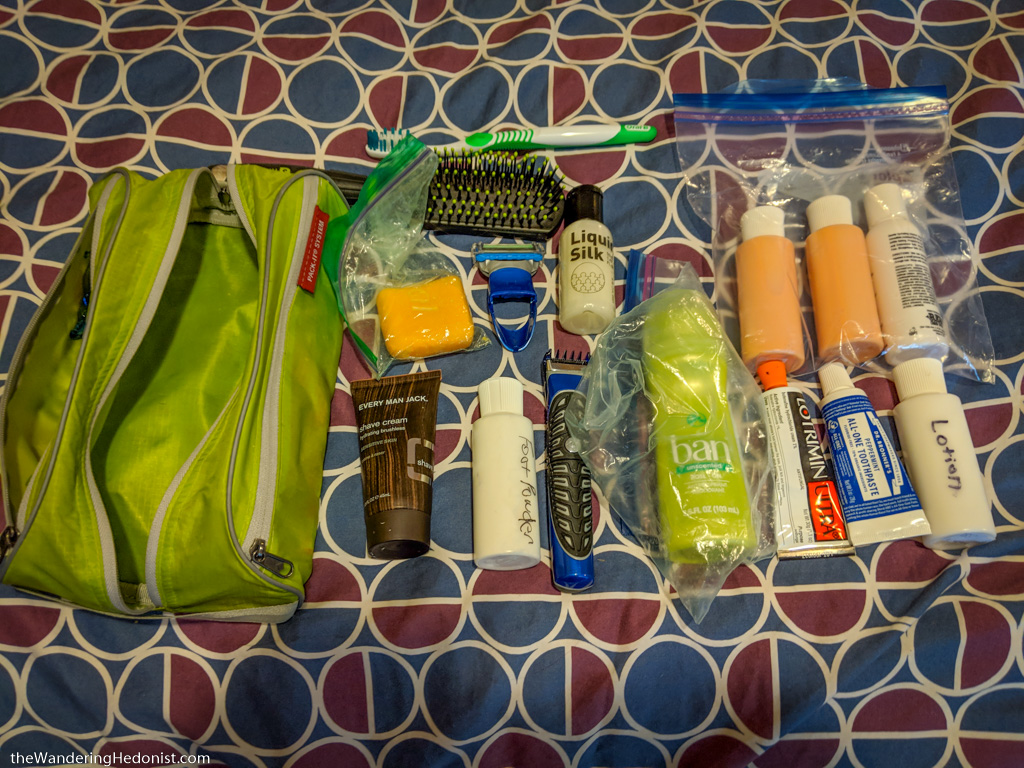
Bag
I use a very light Sea to Summit toiletries bag. Works perfectly for me.
Inside I have:
– Deodorant
– Shave and beard kit (more below)
– Half bar of soap (I like dial bar soap so I bring a half bar with me in a snack baggie)
– Hairbrush (I know, luxury, but have to look good)
– Foot powder that I loaded into a 2.5oz shampoo bottle. This works for foot issues or for any chaffing I might get.
– Side pocket (sewing kit, hair ties, ear plugs, lube and condom, safety pins, eyeglass screwdriver, chapstick, toothpick/flosser, a couple twist ties)
Shave and beard kit
As a guy with a beard I need to have a beard trimmer. For normal vacations I go without but long term I had to solve this problem. My normal trimmer was too bulky. So I ditched it and bought this little guy at a Target, the Gillette Fusion Styler. It’s perfect! Very light weight, uses a single AA battery. It trims a bit closer than I normally do but not too bad. And Katy even used it to buzz my head which took a few hours, it might be worth it to just go to a barber, but it will work in a pinch. They keep it with the razors not the trimmers. Took me like an hour to figure that out.
It’s small enough that I could eliminate my razor I used for moustache trimming. It even comes with a razor attachment that can be used as a razor without a long handle. Works great for me. So I could eliminate my regular razor too.
Normally I also carry shave gel in a can but that was too heavy and bulky. After some experimentation I ran across this shaving lotion that was light and compact and worked great and was free from scents. I can use just a little squirt and has been performing great. A great space saver.
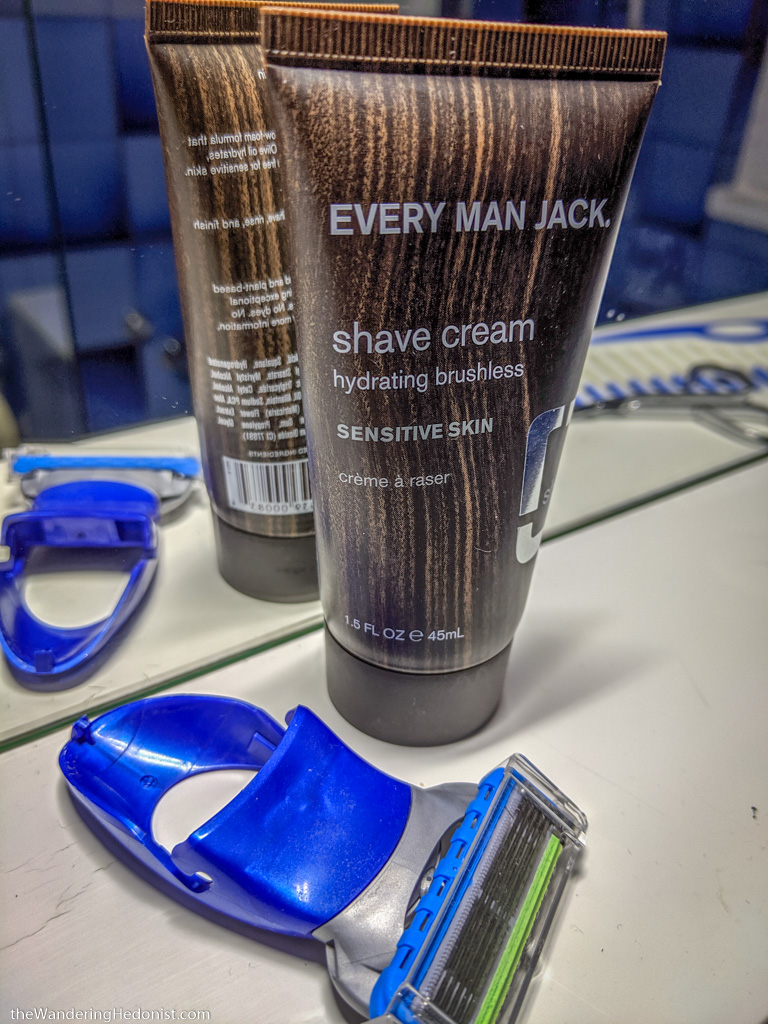


Liquids
I separated my liquids out into their own bag for easy security screening. I have one ziplock with a travel size tube of color safe shampoo, my lotion that I transferred to a 2.5oz container, and two bottles of my medicated shampoo that I can’t buy abroad. I’ll have to see how much I use but ok so far. I have a second ziplock with a small tube of sunscreen, travel toothpaste, and foot cream. I put both of these in a gallon ziplock and stuff them in my bag’s top external pocket.



First aid
I bought a tiny zip up canvas first aid kit and basically dumped it out and started with my own stuff. I’ve been adapting this over the years to account for things I encounter. It’s probably too indepth to explain why everything is in here but I can show a pic of what I travel with so you get an idea.
Also, a small swiss army knife, metal tweezers, a small whistle, large nail clippers. These can get confiscated in carry-on. I’ve checked this bag for international flights so far. I’ll see how long I can keep them.


Travel kit
I also have an XS Sea to Summit packing cube that I keep some essentials in. Bug spray, extra condoms, multi symptom flu medicine and Benadryl (hard to get overseas), some extra ibuprofen, Tylenol, and Excedrin, antibiotics, a wine bottle opener, and extra earplugs (for other hostel residents, I snore like a bear). Ideally I would transfer the benadryl into a tiny plastic bag an lose the heavy packaging but I forgot to bring extras.

Other personal items
I also pack a few other items in my bag.
1 – REI packable day pack. Great for day hikes, use it constantly. This is what Katy uses as her travel backpack.
1 – Patagonia packable fanny pack. Great for the beach.
1 – REI small microfleece towel.
1 – Bottle of Prilosec OTC loaded with about 6 bottles worth of pills. I have acid reflux.
Several small plastic bags for segregating wet or dirty clothes, storage, etc. Very useful.
Hiking poles – The trifold kind that break down small enough to fit in a carry-on. I use the Leki Micro Vario Carbon poles. They’re expensive but ideal for travel and I need a good pole because of my janky knees.

My backpack
I usually travel with a larger laptop style backpack and I’ve gotten used to all of that storage. I could go smaller but I like my bag and it works for me. I have a fairly generic REI bag. Ideally as I go along I can pair down my roller and move some of the backpack items to it to reduce my back weight, easier on my knees, but it’s fine for right now. I’m also writing a full blog that’s travel photo heavy so I need a decent workflow and equipment. I can detail what I use and how I work here as well.
Camera kit
I’ve discovered less is more for photo equipment. I’m leaving my Canon 7D and lenses at home and bringing my Canon M6 mirrorless camera with only my 22mm fixed pancake lens. With lens factor that gets me basically a 35mm equivalent lens that’s perfect for general travel. I weighed the space and care needed for extra lenses and equipment and found I couldn’t justify a more robust kit. Everything you see on this site is either shot with it or my phone.
I can carry my camera in a small black pouch on my belt so I always have it with me. Which means I use it much more.
I also brought a lightweight tripod, essentially made of tent poles weighing 9 oz. and is only 9″ when folded. The one I bought is no longer available but this one is pretty similar but a bit taller and weights a bit more at 11.5oz but still lighter than the nearest competitor. Not for big cameras or high wind but very packable. Fits in my back pocket.
And I bought this small quick release system for convenience.
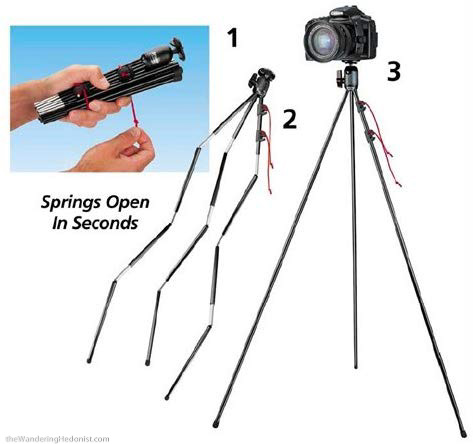

I travel with three extra batteries and a charger, a USB SD card adapter, a remote, and that’s about it.
I use my Pixel 3 as my backup camera and for times when I need a bit wider angle or when I don’t want to bring my camera along.
Laptop and blogging workflow
Katy uses the cloud version of Lightroom and likes to work from her phone but I prefer the classic version of lightroom and work from my laptop. It has more control, a better screen, and I don’t need wifi to work on my images. It’s a personal choice. I chose the Asus Zenbook 13″ with i7 processor, 16gb of ram and a 512gb SSD. At 2.6 pounds it travels well but still performs. Katy chose the slightly better but more expensive Dell XPS 13 that weighs the same.
To augment the smaller hard drive I bought an external 2tb SSD. Pricey at $270 but it’s so tiny! The SSD paired with the USB C cable is as fast as an internal SSD. I transfer my camera and phone pics to the drive and run a separate lightroom catalog file directly from the SSD so when I fill it up I can start over with a new one without affecting the laptop drive.
I work completely local then upload images as I need them to my server while I’m writing blogs. It’s been working really well for me.
Electronics kit
I also group all of my other electronics in another XS Sea to Summit bag for easy access and easy removal if needed like in the India airports.
– Goal Zero Flip 2.0 battery
– 3.5mm ear buds with USB C adapter for my phone
– Dual male 3.5mm cable
– Short HDMI cable to connect a laptop to a hotel TV (my laptop has native HDMI)
– Rapid phone charger with 9′ cable for those rooms with weird plug locations
– Small extra USB charger
– Plug adapters for UK, EU, and AU. I prefer the plug adapters over the all-in-one adapter blocks because it’s smaller and more adaptable. Katy uses the block. Pros and cons.
– Small rechargeable LED mood light for rooms with only a blinding overhead light.
– USB C to USB cable to connect my phone to the laptop.
– A USB C to USB adapter for coverage.
Quick travel accessories
My backpack has a small top compartment that I keep filled with travel emergency essentials I hope I don’t need to use but it’s good to have if you do.
– Small bit of toilet paper in a baggie
– Small container of wipes
– Small pack of tissues
– Cough drops
– Breath mints
– Antacids
– Small roll of duct tape
– A length of thin synthetic rope for a clothesline
– Chopsticks and tiny plastic spoon
– Toothpick / flosser
– Hair tie
– Small LED area light
Notebooks and pens
I like to write by hand so I bring like 8 pens in different styles, a large moleskin unlined notebook and a small unlined moleskin notebook. It was hard for me to get down to just these two. But I honestly haven’t had time to use them yet.
Headphones
I like quality music so I splurge and bring over the ear bluetooth headphones. I really love these things. The external pocket on my backpack fits the hard shell case perfectly and I can pull them out easily. Bose QuietComfort 35 II Wireless Headphones. I got a massive employee discount at Amazon but I’ve been really happy with these.
Water bottle
I prefer a half liter Smart Water bottle over the commercial kind. It’s lighter and a good resize. I just empty it before flying and refill at the gate. For hiking I like the 1 liter Smart Water bottles because they’re tall and skinny and fit backpack pockets better.
Packing everything up!
So how do I make all that fit in my little bag? I’ve had to pack and repack this thing so many times it’s automatic at this point. A good packing configuration will help you not have to unpack the whole bag every time you need something. I put mine together like this:
The rolling handle slides down the back bottom of the bag leaving a channel on either side. I put my long socks in one channel and my short socks and underwear in the other channel. This way I can differentiate by feel and it flattens the base out for my larger layers.
I stack my sandals in the bottom of the bag. I rarely need to pull these out and it gets them out of the way.
I then make a single stack of clothes pushed to the far right and back as far as they’ll comfortably go without wrinkling. I start with my heavy jeans and thai pants, then my dress shirt (I use these less), then my synthetic shirt, synthetic pants, then stack my tshirts. I stuff my puffy in it’s pouch and it fits nicely in the left hand channel I’ve created. I push it towards the shoes (bottom of the bag). Above that I roll my raincoat and fill the rest of the channel. This allows me to partially unzip the roller bag and pull out either the puffy or raincoat without disturbing anything else.
This also leave a little bit of room as the handle end of the bag (opposite of the shoes). I roll my shorts and base layer leggings and fill this space. I then put my two glasses cases under a couple of shirts in vertical stripe across the right side of the clothes stack. In the center I lay the hiking poles vertically. I stuff the baseball cap bill between the clothes stack and the puffy and let the mesh fold flat. Over all of this I lay the shade hat and we’re golden.
In the full length mesh pocket I stuff the travel assessories bag at the bottom sideways then the toiletries bag vertically above it leaving a channel by the zipper for the first aid kit and the Prilosec bottle. The toiletries bag lays parallel to the hiking poles but doesn’t overlap. Then I zip the bag closed.
Outside pockets.
In the outside flat pocket I store the towel, packed travel backpack, fanny pack, plastic bags, and windbreaker stored loose, not packed. This all fits neat and flat.
In the small top handle side pocket I stuff in the baggie of liquids for easy removal later if needed.
All packed!

Things I’ve culled from my original pack
I thought this might useful. Things I’ve gotten rid off. When I left on our trip originally I didn’t really know what I’d be using. I have a bunch of things I’ve used on various other trips. I went trim but brought some extra stuff. After a few missed flights getting to my parents I decided I need to pair some stuff down. Here’s what didn’t make the first cut.
Headlamp – I’ve used this a lot in the past but it seemed a bit redundant. I probably won’t be hiking in the dark and I have a small LED area light and the light on my phone. I haven’t missed it yet.
Inflatable pillow – It’s tiny. I wanted a backup. But haven’t missed it.
Sea to Summit waterproof packable backpack – Redundant with my REI backpack and I just put things in ziplock bags inside.
Synthetic shirt – I brought two in hopes I would convert to them but Katy convinced me I only needed one and that feels right so far. I wear the tshirts more. We’ll see over time.
Thermal leggings – Tough call but I decided the jeans would be more used by me. The thermals are better on paper but honestly I’m not planning on many long snow days and I don’t like my legs to be really hot. Going from outside to inside with these might be uncomfortable. But they’re lighter and dry faster. I’m open to reconsider.
Money belt – Seemed useful but I just needed the space.
Redundant medicine – I went a little overboard with my favorite medicines. I had double packed them between my bags and it was way too much. I haven’t really missed any of this stuff so far. Same with condoms. You can buy these anywhere.
Packaging – I made a second effort to reduce all the packaging I was bringing. Moving pills to little ziplock backs and removing packaging from other things really helps. Its little but adds up. Plus it packs smaller overall.
Business card holder – I had a dream of carrying around business cards and handing them out to all of the people that we meet. But honestly a snack ziplock bag works just as good and I haven’t handed out all that many cards.


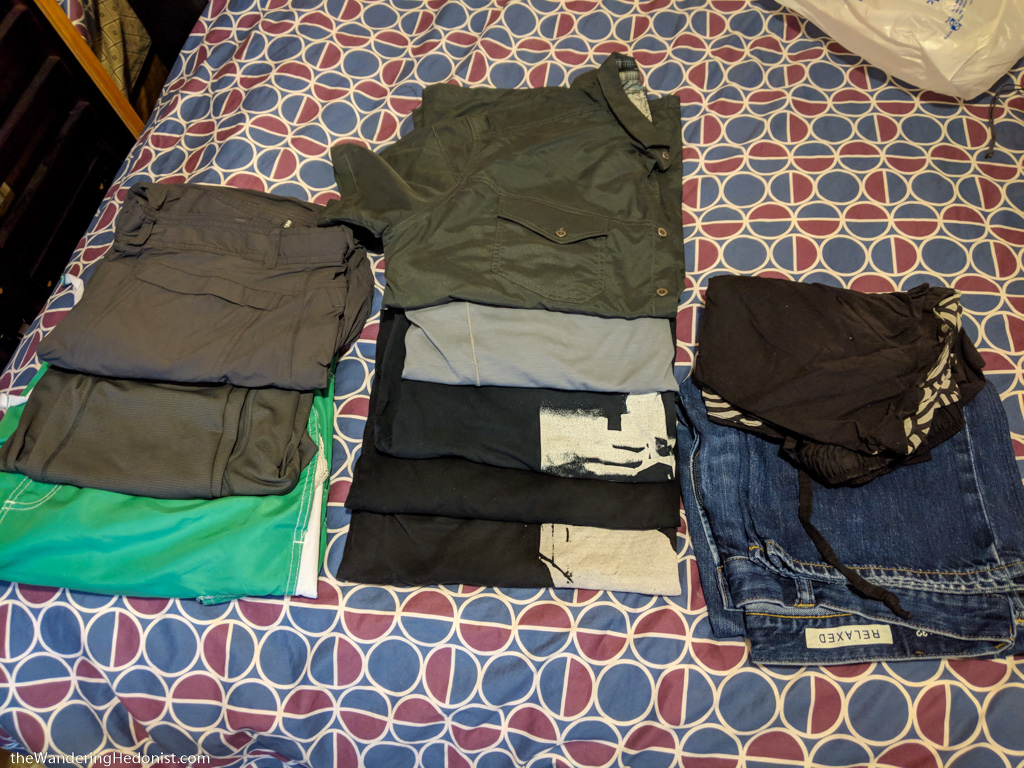
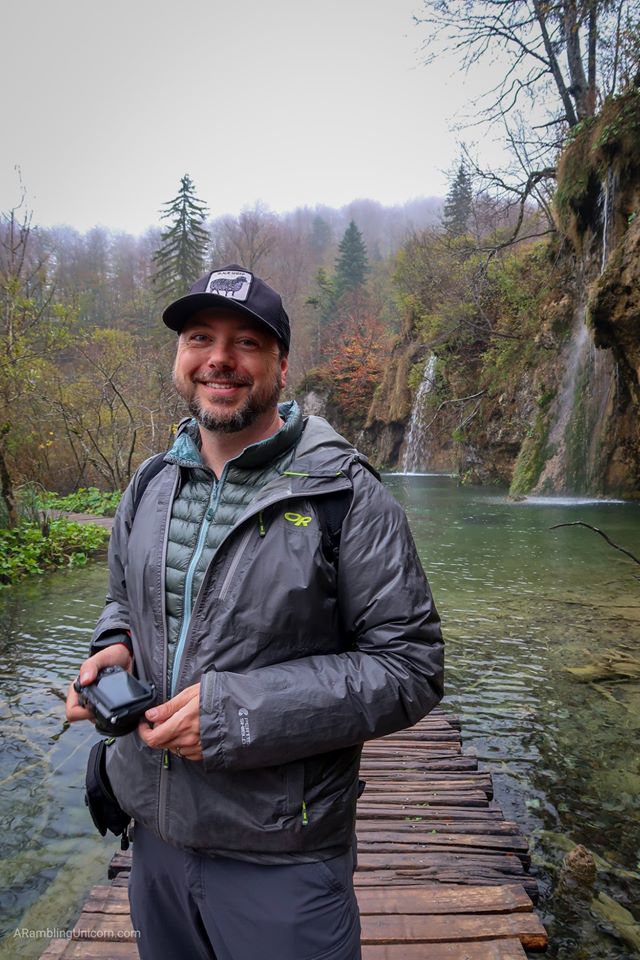
















No Comments